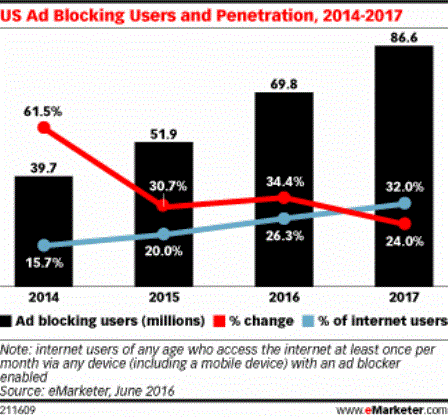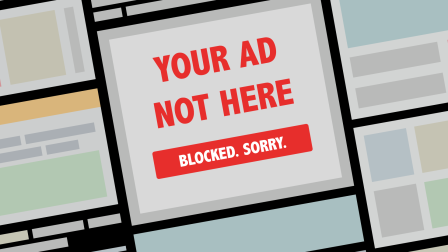Forecast argues 33 percent of internet users will be ad blocking by next year
Growth of ad blocking requires more soul-searching, faster action by industry.

The now almost-cliche response to the issue of ad blocking is: “Deliver better ad experiences that consumers don’t want to block.” Easier said than done. Indeed, there’s no simple solution to this growing industry challenge.
Forecaster eMarketer estimates that this year, 70 million people in the US will use ad blockers, representing growth of nearly 35 percent year over year. Next year, the company estimates that nearly 87 million internet users in the US will be blocking ads.

Earlier this year, PageFair released a mobile ad-blocking report indicating that 419 million people around the globe were blocking ads on mobile devices. The majority were located in Asia, fewer in North America and Europe. However, the eMarketer projections suggest that roughly one-third of US internet users will be blocking ads next year.
According to online polling firm CivicScience, 55 percent of survey respondents had ad blockers on their PCs, and 25 percent had them on their smartphones. This was based on a survey of more than 11,000 mobile and PC users over the past six months.
These penetration figures are likely higher than the general internet population. Regardless, they should be very worrisome to publishers and marketers. Here are some of the demographic data CivicScience captured in that survey:
- Mobile blockers are more likely to be 25 to 54 years old; desktop blockers skew younger or older.
- Mobile blockers have higher incomes; 34 percent had incomes over $100,000.
- Mobile blockers are more likely to be parents than desktop blockers.
- African Americans and Hispanics are more likely than Caucasians to be mobile blockers.
The CivicScience data also examined ad blocking and various affinities, such as political engagement, device ownership, interest in sports, fashion, fitness and brand affinities. More of that data can be accessed via the company’s webinar.
Coercive approaches to ad blocking are unlikely to succeed. Higher quality and improved ad experiences (including speed improvements) are critical. Facebook, Google, Yahoo and AOL, as well as a few others, are in a position to help nudge the industry toward those solutions. The IAB’s LEAN initiative may also help.
I’m not optimistic. That’s because there’s a fairly massive gap between rhetoric and reality in terms of addressing the problems and issues that are driving mass adoption of ad blockers.
Marketing Land – Internet Marketing News, Strategies & Tips
(14)



